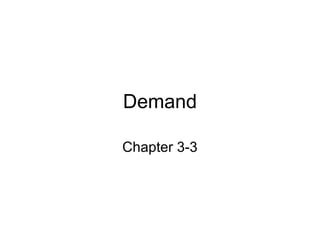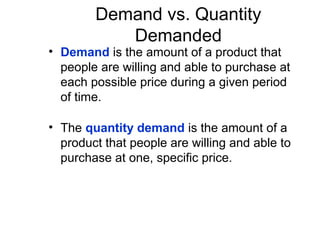Economic Demand
- 2. Laugher Curve Q. What do you get when you cross the Godfather with an economist? A. An offer you can't understand.
- 3. Demand ? Demand means the willingness and capacity to pay. ? Prices are the tools by which the market coordinates individual desires.
- 4. Demand vs. Quantity Demanded ? Demand is the amount of a product that people are willing and able to purchase at each possible price during a given period of time. ? The quantity demand is the amount of a product that people are willing and able to purchase at one, specific price.
- 5. The Law of Demand ? Law of demand ®C there is an inverse relationship between price and quantity demanded. ®C Quantity demanded rises as price falls, other things constant. ®C Quantity demanded falls as prices rise, other things constant.
- 6. The Law of Demand ? What accounts for the law of demand? ®C People tend to substitute for goods whose price has gone up.
- 7. The Demand Curve ? The demand curve is the graphic representation of the law of demand. ? The demand curve slopes downward and to the right. ? As the price goes up, the quantity demanded goes down.
- 8. The Demand Table ? The demand table assumes all the following: ®C As price rises, quantity demanded declines. ®C Quantity demanded has a specific time dimension to it. ®C All the products involved are identical in shape, size, quality, etc.
- 9. The Demand Table ? The demand table assumes all the following: ®C The schedule assumes that everything else is held constant.
- 10. From a Demand Table to a Demand Curve ? You plot each point in the demand table on a graph and connect the points to derive the demand curve.
- 11. From a Demand Table to a Demand Curve ? The demand curve graphically conveys the same information that is on the demand table.
- 12. PriceperDVDs(indollars) A Demand Curve Quantity of DVDs demanded (per week) 1 2 3 4 5 6 7 8 9 10 11 12 13 $6.00 5.00 4.00 3.00 2.00 1.00 .50 0 3.50 E D C BF A From a Demand Table to a Demand Curve Price per cassette A B C D E A Demand Table DVD rentals demanded per week $0.50 1.00 2.00 3.00 4.00 9 8 6 4 2 Demand for DVDs G
- 13. D Price(perunit) 0 Quantity demanded (per unit of time) PA QA A A Sample Demand Curve
- 14. Demand Schedule and Demand Curve for DVDs
- 15. Other Things Constant ? Other things constant places a limitation on the application of the law of demand. ®C All other factors that affect quantity demanded are assumed to remain constant, whether they actually remain constant or not.
- 16. Other Things Constant ? Other things constant places a limitation on the application of the law of demand. ®C These factors may include changing tastes, prices of other goods, income, even the weather.
- 17. ? Demand refers to a schedule of quantities of a good that will be bought per unit of time at various prices, other things constant. ? Graphically, it refers to the entire demand curve. Shifts in Demand Versus Movements Along a Demand Curve
- 18. ? Quantity demanded refers to a specific amount that will be demand per unit of time at a specific price. ? Graphically, it refers to a specific point on the demand curve. Shifts in Demand Versus Movements Along a Demand Curve
- 19. ? A movement along a demand curve is the graphical representation of the effect of a change in price on the quantity demanded. Shifts in Demand Versus Movements Along a Demand Curve
- 20. ? A shift in demand is the graphical representation of the effect of anything other than price on demand. Shifts in Demand Versus Movements Along a Demand Curve
- 21. Change in Quantity Demanded D1 Change in quantity demanded (a movement along the curve) B 0 Price(perunit) Quantity demanded (per unit of time) 100 $2 $1 200 A
- 22. D0 D1 Shift in Demand Price(perunit) Quantity demanded (per unit of time) 100 $2 $1 200 B A Change in demand (a shift of the curve) 250
- 23. Determinants of Demand TastesTastes IncomeIncome Number of buyersNumber of buyers ExpectationsExpectations Prices of related goodsPrices of related goods
- 24. Shift Factors of Demand ? Shift factors of demand are factors that cause shifts in the demand curve: ®C Society's income. ®C The prices of other goods. ®C Tastes. ®C Expectations. ®C Number of Buyers ®C Taxes on subsidies to consumers.
- 25. Income ? An increase in income will increase demand for normal goods. ? An increase in income will decrease demand for inferior goods.
- 26. Price of Other Goods ? When the price of a substitute good falls, demand falls for the good whose price has not changed. ? When the price of a complement good falls, demand rises for the good whose price has not changed.
- 27. Tastes ? A change in taste will change demand with no change in price.
- 28. Expectations ? If you expect your income to rise, you may consume more now. ? If you expect prices to fall in the future, you may put off purchases today.
- 29. Individual and Market Demand Curves ? A market demand curve is the horizontal sum of all individual demand curves. ®C This is determined by adding the individual demand curves of all the demanders.
- 30. Individual and Market Demand Curves ? Sellers estimate total market demand for their product which becomes smooth and downward sloping curve.
- 31. From Individual Demands to a Market Demand Curve (1) Price per cassette $.0.50 1.00 1.50 2.00 2.50 3.00 3.50 4.00 (2) Alice°Øs demand (3) Bruce°Øs demand (2) Cathy°Øs demand (3) Market demand 9 8 7 6 5 4 3 2 6 5 4 3 2 1 0 0 1 1 0 0 0 0 0 0 16 14 11 9 7 5 3 2 A B C D E F G H Cathy Bruce Alice D A C E F G Quantity of cassettes demanded per week 2 $4.00 3.50 3.00 2.50 2.00 1.50 1.00 0.50 0 Pricepercassette(indollars) 4 6 8 10 12 14 16 B Market demand McGraw-Hill/Irwin ? 2004 The McGraw-Hill Companies, Inc., All Rights Reserved.
- 32. Aggregation of Demand (I)
- 33. Aggregation of Demand (II)
- 34. Factors that Shift Demand Consumer Income Tastes And Preferences Demographics Expectations Price of Related Goods Number Of Buyers Demand
- 35. Taxes and Subsidies ? Taxes levied on consumers increase the cost of goods to consumers, thereby reducing demand. ? Subsidies have an opposite effect. Not in your book but something you should think about
- 36. Changes in Demand and Quantity Demanded ? Change in Quantity Demanded - movement along the same demand curve in response to a price change. ? Change in Demand - shift in entire demand curve in response to a change in a determinant of demand (a ceteris paribus variable)
- 37. Change in Demand vs. Change in the Quantity Demanded
- 38. The Law of Demand ? The demand curve is downward sloping for the following reasons: ®C At lower prices, existing demanders buy more. ®C At lower prices, new demanders enter the market.






































